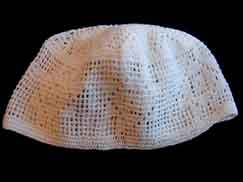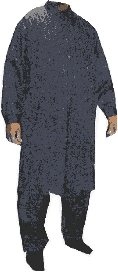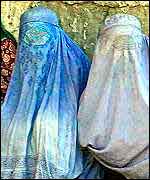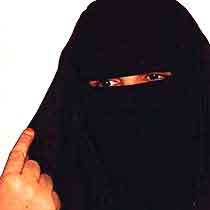

Islamic dress: modesty and ethnicity
As in Judaism, customary dress is often a marker of religious identity, particular in countries in which Muslims comprise a religious minority. And yet, like other forms of cultural expression, Islamic dress provides an opportunity for the universal sunna of Islam to be adapted to the cultural norms of the nation in which Islam is being practiced.
The primary obligation of Muslims, according to the sunna, is to dress modestly. This is generally taken to mean covering the head, arms, and legs when in public. The head-covering for men can take many forms, from the Turkish turban, to the Middle Eastern (primarily Arabian) long head covering, to the small cap known as the kufi, as pictured here:


Male clothing can also vary widely. One way of covering one's arms and legs with appropriate modesty is through a loose-fitting, two piece "suit":

This suit is from an on-line catalogue of Islamic clothes.
In addition to the modesty incumbent on all Muslims, women are believed to be targets of inappropriate male gazes (from Muslims and non-Muslims). The broad nature of this custom of modesty--"arms, legs, and heads"--has been diversely understood, even in the twenty-first century. Issues of western feminism (as well as Islamic feminism, which focuses on the liberating aspect of covering one's body) further complicate issues of what has generally been called "veiling of women" in Islam. (This term, "veiling," often carries certain stereotypes of gender inequality; in fact, the custom of modesty in clothing applies to men and women).
It seems that much of the variety in female modest dress has to do with the cultural norms of gender, dress, and sexuality already in existence in the nation in which Islam has taken route. Below are some contemporary examples of this custom of "modest dress" in Islam.

These women are dressed in the head-to-toe burqa, which conceals a woman in public entirely. The material is thinner around the eyes. This is perhaps the most severe interpretation of "modest dress" for women, and seems to result from particularly rigorist interpretations of shari'a.

This woman (from Dubai) is pictured wearing the niqab, which also covers from head-to-toe, but leaves an opening for the eyes.
The most common form of female head covering, particularly in "western" nations (those in which Muslims are a minority) is the hijab, the scarf wrapped around the head:


No matter what the degree of "modesty" conveyed by dress--and no matter what the interpretation of that modest dress, both within a particular Islamic nation and from non-Muslims who consider the subject--the general command of the sunna guarantees that, in most Islamic communities, there will be a certain degree of "public face" that comes with one's religion (by contrast, one can generally not tell a Christian or modern-dress Jew on sight unless they choose deliberately to mark their appearance).
end of slide show